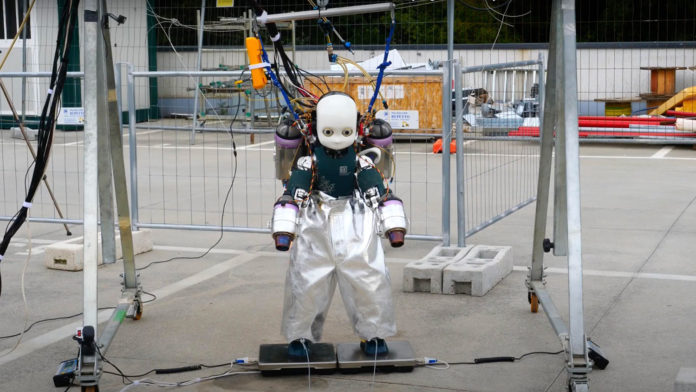Researchers at the Italian Institute of Technology (IIT) are developing iRonCub, a small humanoid robot that looks like a kid but it’s carrying four jet engines instead of a backpack. The four jet engines give it the ability to fly like Iron Man.
iRonCub has two jet engines clipped onto the back of the robot and two jet engines on the forearms. It is also sporting what looks like a cool pair of metallic pants, but it’s actually made of heat-resistant material to protect the robot from the jet engines’ fire. However, a new and updated version of iRonCub has flame-protective coverings on its legs and feet.
It is difficult to measure thrust forces, so they are usually estimated based on data collected by onboard sensors. Now the IIT team has introduced a new framework that can estimate thrust intensities of flying multibody systems that are not equipped with thrust-measuring sensors. This framework could ultimately help them to realize their envisioned flying humanoid robot.

One of the key aims for this project is making robotic aerial manipulation more robust and energy-efficient than ever before. As explained by Daniele Pucci, head of the Artificial and Mechanical Intelligence lab at the institute, aerial humanoid robots can be technologically, socially, and scientifically beneficial. Aerial humanoid robots like iRonCub can help improve flying robots which are mostly quadrotors equipped with a robotic arm.
These robots can’t move around by means of contact forces with the environment, and they typically struggle to fly in windy conditions while manipulating objects, requiring precise position control for accomplishing manipulation tasks. Pucci believes that the extra hand of a flying humanoid robot could establish a contact point between the robot and the environment, thus making the robot position control simpler and more robust.
On the other hand, the iRonCub experiences will allow researchers to refine propulsion technology and advance aerodynamics to develop future flying exoskeletons for human beings. The process behind making an aerial humanoid robot fly properly also raises multiple theoretical and practical questions which can help scientifically in the development of robots.
Project engineers admit they still have a long way to go, but they hope iRonCub will be able to conduct controlled flights soon. The next challenge is to make iRonCub fly with a flight controller, and the final result could be seeing a mini version of Iron Man up in the sky.
